![How Common is Sexting [Facts & Statistics]](https://wp.bedbible.com/wp-content/uploads/2024/05/Sexting-statistics.png)
We’ve collected and aggregated longitudinal survey data on self-reported sexting behaviors of 110,380 teenagers and 54,677 adults. Collectively this makes it the largest longitudinal dataset on sexting ever created with a world of insights hidden within. In this article, we share some of our findings from analyzing the extensive dataset.
Table of contents:
- Sexting over time
- Comparing teenagers and adults
- Teens and sexting
- Age and Gender differences in sexting
- Reasons for sexting
- Forwarding/Sharing sexting without consent
- Other studies
Key Findings
- 9 out of 10 adults have sent or received a sexual message, an image, or a video.
- 1 in 5 teenagers has taken part in sexting – sending, or receiving sexually nude or nearly nude photos through text or email.
- 1 in 7 teenagers has exchanged sexts (with images or videos) with a partner.
- Over 50% of adults reluctantly engaged in sexting.
- 18% of people have shared a sexting message with others without consent, of which 55% share it with more than one other person.
- 24% of teenagers aged 14-18 have sent sexts with images
- 39% of parents report feeling worried their child may engage in sexting
Sexting over time
After aggregating and collecting data on different aspects of dating the first thing we did was look into the historical development of sexting in the survey responses.
We looked at the prevalence of respondents reporting they have sent a sexting message and if they report having received a sexting message. We also looked at how many have shared a sexting message with a third party without consent to do so. We split the data on teenagers, aged 11-18; and adults, aged 19+.
Sexting prevalence amongst adults over time
The data shows that in 2023 the following is reported of adults about their sexting behavior:
- 87.9% of adults report that they have received a sexting message.
- 76.9% of adults report that they have sent a sexting message.
- 18.2% of adults report that they have shared a sexting message without consent.
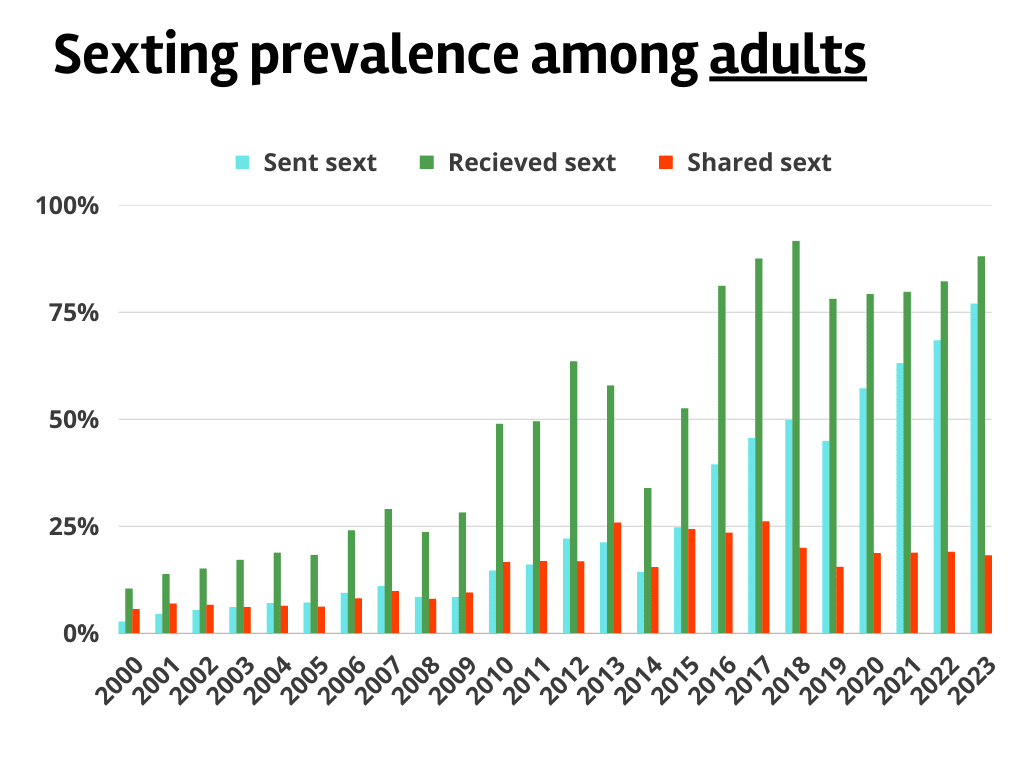
The raw data is available in the below table:
| Among Adults (+19) | Sent sext | Received sext | Shared sext |
|---|---|---|---|
| 2000 | 2.7% | 10.3% | 5.6% |
| 2001 | 4.5% | 13.7% | 6.9% |
| 2002 | 5.4% | 15% | 6.6% |
| 2003 | 6.1% | 17% | 6.1% |
| 2004 | 7% | 18.7% | 6.4% |
| 2005 | 7.1% | 18.2% | 6.2% |
| 2006 | 9.4% | 23.9% | 8.1% |
| 2007 | 11% | 28.9% | 9.8% |
| 2008 | 8.5% | 23.5% | 8% |
| 2009 | 8.4% | 28.1% | 9.5% |
| 2010 | 14.6% | 48.8% | 16.6% |
| 2011 | 16% | 49.4% | 16.8% |
| 2012 | 22.1% | 63.4% | 16.8% |
| 2013 | 21.2% | 57.8% | 25.8% |
| 2014 | 14.3% | 33.8% | 15.4% |
| 2015 | 24.7% | 52.4% | 24.3% |
| 2016 | 39.4% | 81% | 23.5% |
| 2017 | 45.6% | 87.4% | 26.1% |
| 2018 | 49.8% | 91.6% | 20% |
| 2019 | 44.9% | 78% | 15.5% |
| 2020 | 57.1% | 79.1% | 18.7% |
| 2021 | 63% | 79.6% | 18.8% |
| 2022 | 68.3% | 82.1% | 19% |
| 2023 | 76.9% | 87.9% | 18.2% |
Sexting prevalence amongst teenagers over time
From the newest recorded data in 2023, teens report the following when asked about their sexting behavior:
- 38.2% of teens report that they have received a sexting message.
- 26.5% of teens report that they have sent a sexting message.
- 13.0% of teens report that they have shared a sexting message without consent.
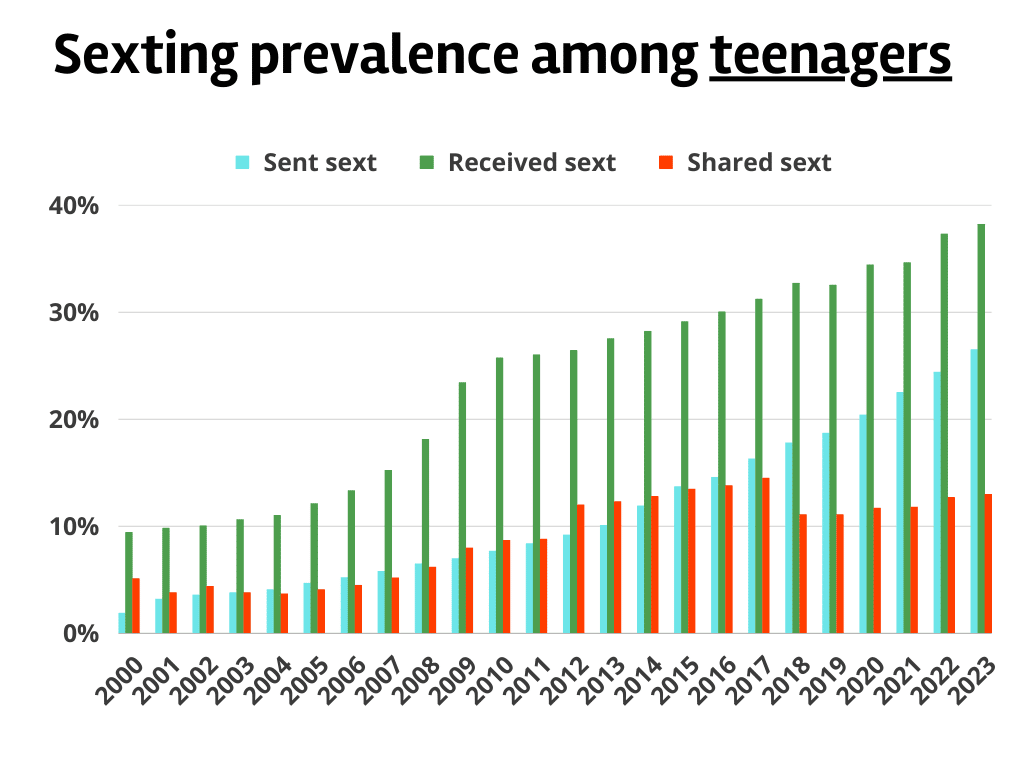
Again, the raw data for teenage sexting prevalence is accessible in the below table:
| Among teens (11-18) | Sent sext | Received sext | Shared sext |
|---|---|---|---|
| 2000 | 1.9% | 9.4% | 5.1% |
| 2001 | 3.2% | 9.8% | 3.8% |
| 2002 | 3.6% | 10.0% | 4.4% |
| 2003 | 3.8% | 10.6% | 3.8% |
| 2004 | 4.1% | 11.0% | 3.7% |
| 2005 | 4.7% | 12.1% | 4.1% |
| 2006 | 5.2% | 13.3% | 4.5% |
| 2007 | 5.8% | 15.2% | 5.2% |
| 2008 | 6.5% | 18.1% | 6.2% |
| 2009 | 7% | 23.4% | 8% |
| 2010 | 7.7% | 25.7% | 8.7% |
| 2011 | 8.4% | 26.0% | 8.8% |
| 2012 | 9.2% | 26.4% | 12% |
| 2013 | 10.1% | 27.5% | 12.3% |
| 2014 | 11.9% | 28.2% | 12.8% |
| 2015 | 13.7% | 29.1% | 13.5% |
| 2016 | 14.6% | 30.0% | 13.8% |
| 2017 | 16.3% | 31.2% | 14.5% |
| 2018 | 17.8% | 32.7% | 11.1% |
| 2019 | 18.7% | 32.5% | 11.1% |
| 2020 | 20.4% | 34.4% | 11.7% |
| 2021 | 22.5% | 34.6% | 11.8% |
| 2022 | 24.4% | 37.3% | 12.7% |
| 2023 | 26.5% | 38.2% | 13.0% |
Comparing teenagers and adults
1. Have sent a sexting message
- There is a clear upward trend in sexting behavior for both teenagers and adults from 2000 to 2023.
- Teens: Started at 1.9% in 2000 and rose to 26.5% in 2023.
- Adults: Began at 2.7% in 2000 and climbed significantly to 76.9% in 2023.
- Notably, the sexting behavior among adults experienced a sharper rise compared to teenagers, especially from 2016 onwards.
- Both teenagers and adults have shown an increasing trend in sexting behavior from 2000 to 2023, with adults experiencing a sharper rise, especially after 2016.
- The growth rate of sexting behavior among adults is more volatile compared to teenagers. This volatility is particularly evident in the mid-2010s for adults.
- Teenagers have had a more consistent and gradual increase in their sexting behavior growth rate over the analyzed period.
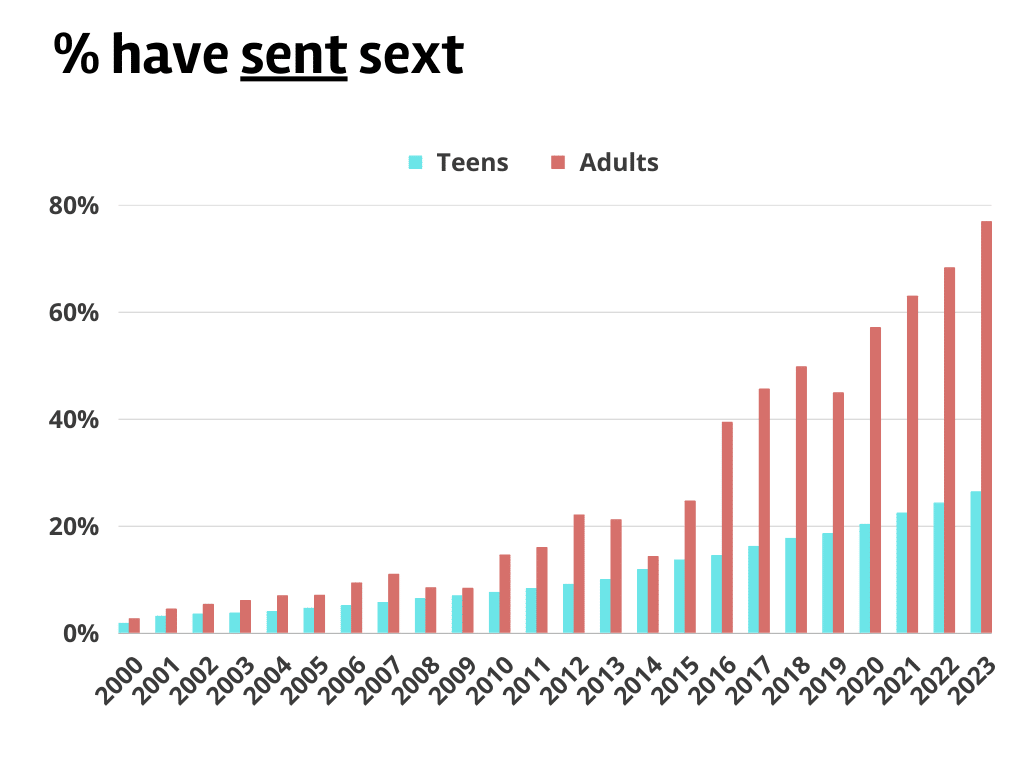
Comparing Growth Rates
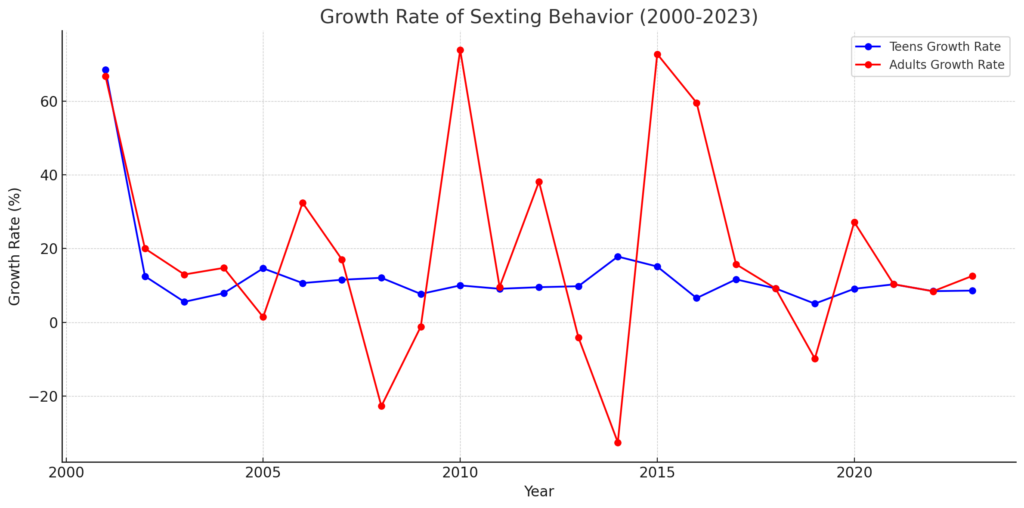
The growth rates of sexting behavior fluctuate over the years for both teenagers and adults.
While both groups experienced increasing growth rates in the early 2000s, the rates tend to fluctuate more significantly for adults. This is especially notable from 2006 onwards.
For adults, there was a marked spike in growth rate around 2016, reaching its peak and then declining, but remaining relatively high.
Teenagers, on the other hand, display a more consistent and gradual increase in their growth rate over the years.
Table with a dataset on teens and adults who sent a sext
| % have sent sext | Teens | Adults |
|---|---|---|
| 2000 | 1.9% | 2.7% |
| 2001 | 3.2% | 4.5% |
| 2002 | 3.6% | 5.4% |
| 2003 | 3.8% | 6.1% |
| 2004 | 4.1% | 7% |
| 2005 | 4.7% | 7.1% |
| 2006 | 5.2% | 9.4% |
| 2007 | 5.8% | 11% |
| 2008 | 6.5% | 8.5% |
| 2009 | 7% | 8.4% |
| 2010 | 7.7% | 14.6% |
| 2011 | 8.4% | 16.0% |
| 2012 | 9.2% | 22.1% |
| 2013 | 10.1% | 21.2% |
| 2014 | 11.9% | 14.3% |
| 2015 | 13.7% | 24.7% |
| 2016 | 14.6% | 39.4% |
| 2017 | 16.3% | 45.6% |
| 2018 | 17.8% | 49.8% |
| 2019 | 18.7% | 44.9% |
| 2020 | 20.4% | 57.1% |
| 2021 | 22.5% | 63.0% |
| 2022 | 24.4% | 68.3% |
| 2023 | 26.5% | 76.9% |
2. Have received a sexting message
- Overall Increase in Sexting: Both teens and adults have seen an increase in the percentage of individuals who have received sexts over the years.
- Steeper Rise for Adults: While both groups saw an increase, the adults’ curve is steeper, indicating a faster rate of growth in the percentage of adults receiving sexts, especially between 2010 and 2018.
- Significant Peaks and Dips: There are noticeable peaks and dips in the data, especially for adults. For instance:
- A significant peak for adults around 2010-2012.
- A sharp decline in 2014 followed by a surge in 2016.
- Another dip in 2019.
- Teens vs. Adults in the Early 2000s: In the early 2000s, the percentage of adults receiving sexts was slightly higher than teens, but this gap increased significantly in the subsequent years.
- Plateauing for Teens: Post-2010, the percentage of teens receiving sexts seems to be increasing at a slower rate compared to the previous decade.
- High Rates in Recent Years: By 2023, more than 1 in 3 teens and almost 9 in 10 adults have received a sext, indicating how common this has become in recent years.
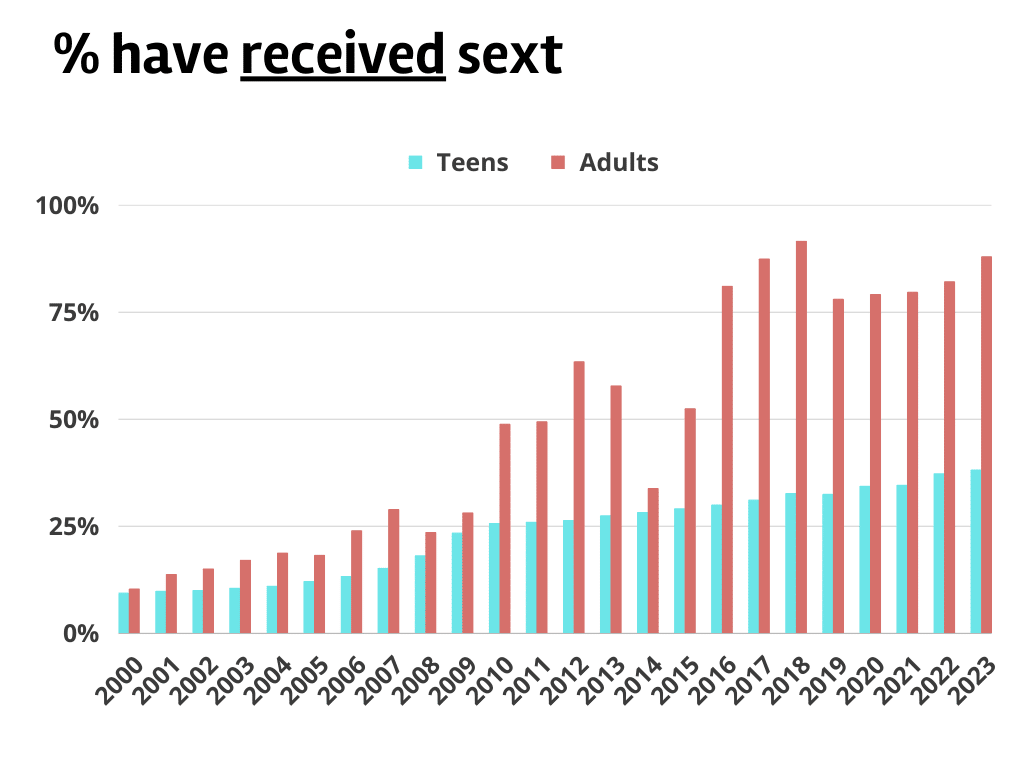
Table with dataset on received sexting messages
| % have received sext | Teens | Adults |
|---|---|---|
| 2000 | 9.4% | 10.3% |
| 2001 | 9.8% | 13.7% |
| 2002 | 10% | 15% |
| 2003 | 10.6% | 17% |
| 2004 | 11% | 18.7% |
| 2005 | 12.1% | 18.2% |
| 2006 | 13.3% | 23.9% |
| 2007 | 15.2% | 28.9% |
| 2008 | 18.1% | 23.5% |
| 2009 | 23.4% | 28.1% |
| 2010 | 25.7% | 48.8% |
| 2011 | 26% | 49.4% |
| 2012 | 26.4% | 63.4% |
| 2013 | 27.5% | 57.8% |
| 2014 | 28.2% | 33.8% |
| 2015 | 29.1% | 52.4% |
| 2016 | 30% | 81% |
| 2017 | 31.2% | 87.4% |
| 2018 | 32.7% | 91.6% |
| 2019 | 32.5% | 78% |
| 2020 | 34.4% | 79.1% |
| 2021 | 34.6% | 79.6% |
| 2022 | 37.3% | 82.1% |
| 2023 | 38.2% | 87.9% |
3. Have shared contents of a sexting message without consent
- Teens:
- From 2000 to 2009, the percentage of teens who shared messages without consent remained relatively low, fluctuating between 3.7% and 8%.
- There was a notable increase from 2009 onwards, peaking at 14.5% in 2017. However, after 2017 there was a slight decline, but the percentages remained higher than the early 2000s, settling around 13% by 2023.
- Adults:
- The percentage of adults who shared messages without consent was relatively stable from 2000 to 2009, ranging between 5.6% and 9.8%.
- Starting in 2010, there was a significant jump, reaching its peak at 25.8% in 2013.
- Post-2013, the percentage saw fluctuations, with noticeable drops in 2014 and 2019. By 2023, it was around 18.2%.
- Comparative Analysis:
- In the early 2000s, the percentages for both teens and adults were relatively close.
- Starting from 2010 onwards, adults generally had a higher percentage of sharing messages without consent compared to teens, with significant disparities in certain years like 2013, 2015, and 2017.
- In the most recent years, the gap between teens and adults has started to close again.
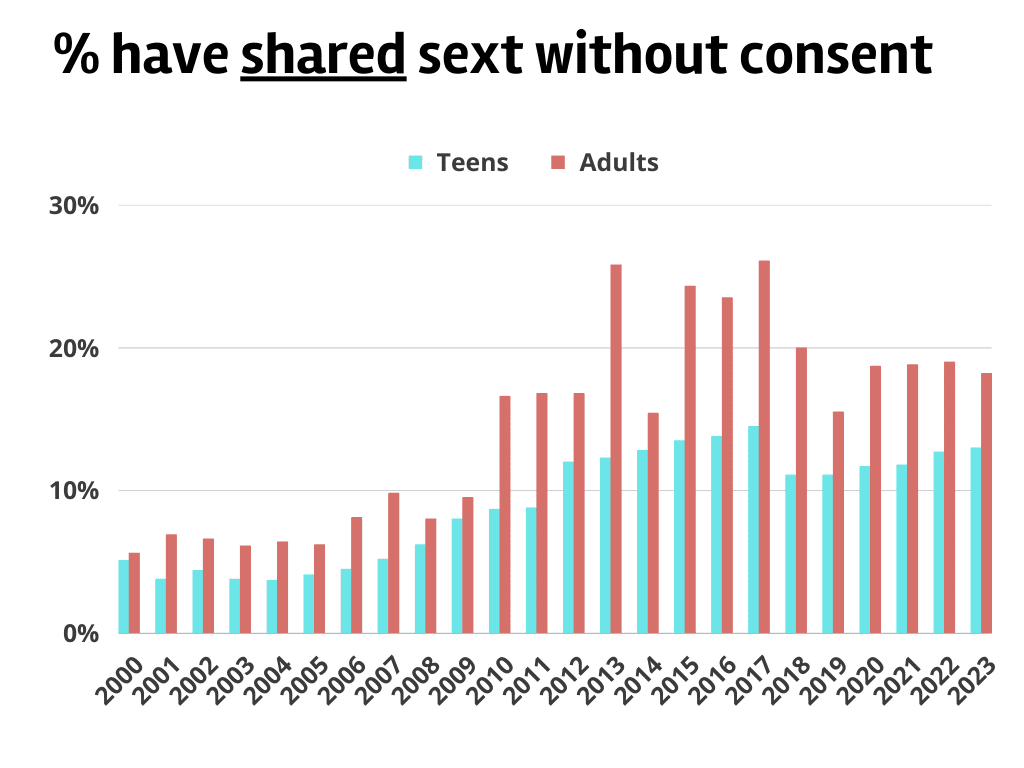
| % have shared sext | Teens | Adults |
|---|---|---|
| 2000 | 5.1% | 5.6% |
| 2001 | 3.8% | 6.9% |
| 2002 | 4.4% | 6.6% |
| 2003 | 3.8% | 6.1% |
| 2004 | 3.7% | 6.4% |
| 2005 | 4.1% | 6.2% |
| 2006 | 4.5% | 8.1% |
| 2007 | 5.2% | 9.8% |
| 2008 | 6.2% | 8.0% |
| 2009 | 8.0% | 9.5% |
| 2010 | 8.7% | 16.6% |
| 2011 | 8.8% | 16.8% |
| 2012 | 12.0% | 16.8% |
| 2013 | 12.3% | 25.8% |
| 2014 | 12.8% | 15.4% |
| 2015 | 13.5% | 24.3% |
| 2016 | 13.8% | 23.5% |
| 2017 | 14.5% | 26.1% |
| 2018 | 11.1% | 20.0% |
| 2019 | 11.1% | 15.5% |
| 2020 | 11.7% | 18.7% |
| 2021 | 11.8% | 18.8% |
| 2022 | 12.7% | 19.0% |
| 2023 | 13.0% | 18.2% |
Teens and sexting
- 1 out of 7 teens aged 12-17 report to have exchanged sexting images or videos with others (14.2%). While 24% of teenagers aged 14-18 have sent a sext containing a video or an image.
- 1 in 5 teens have taken part in some form of sexting; sending, receiving, or sharing sexts (all with images or videos).
- 40% of teens report having engaged in sexting (sexually explicit messages, images, or videos).
- 70% of teenagers who report to have sent an image or a video based sext to a partner felt coerced or pressured into doing so.
- Teenage girls are 20% more likely to send a semi-nude or nude photo in a sext (22%) comared to teenage boys (18%).
- 39% of parents of teenagers report to feel worried their child might engage in sexting.
Age and Gender differences in sexting
Looking at some demographical differences of the most recent data (2020-2023) there are some interesting findings in tabulating the dataset.
In general the data shows that:
- Women report to sext proportionally more than men
- 70% of women believe that sexting is considered cheating
Sexting to others
- Females consistently sext more than males across all age groups. The largest gap is seen in the “Adult, 41-60” group, where 88.4% of females sent a sext compared to 65.4% of males.
- Sexting is most prevalent in the “Adult, 41-60” age group, with 76.9% for all, 65.4% for males, and a significant 88.4% for females.
- The youngest age group (Teenager, 11-18) has the lowest percentage of individuals who sent a sext, but there’s still a clear gender disparity, with females (31.8%) sexting more than males (21.2%).
- As expected, the “All adults” category averages out the adult age groups and showcases the overall trend of females sexting more than males.
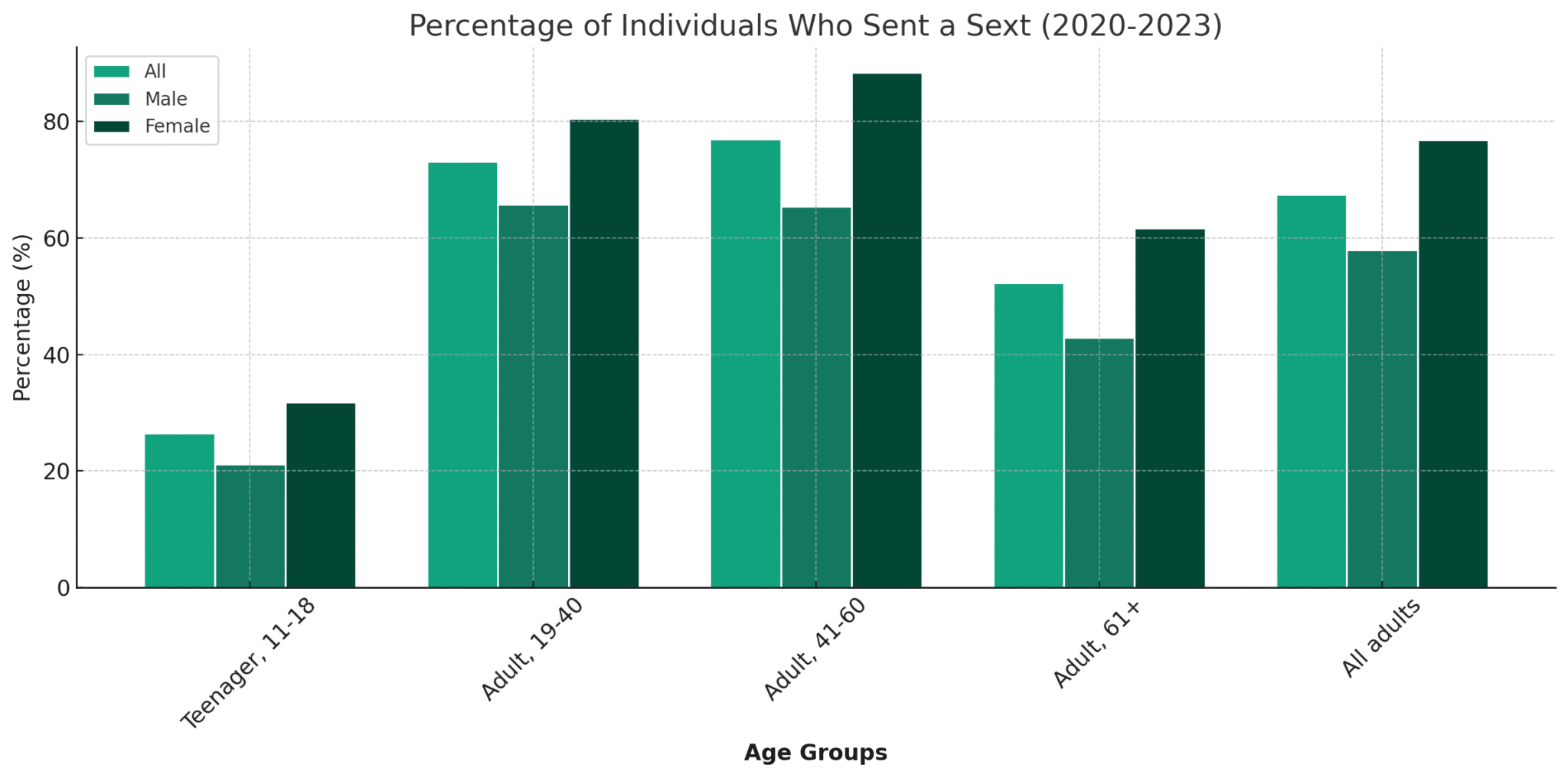
| % Sent sext | All | Male | Female |
|---|---|---|---|
| Teenager, 11-18 | 26.5% | 21.2% | 31.8% |
| Adult, 19-40 | 73.1% | 65.7% | 80.4% |
| Adult, 41-60 | 76.9% | 65.4% | 88.4% |
| Adult, 61+ | 52.3% | 42.9% | 61.7% |
| All adults | 67.4% | 58.0% | 76.8% |
Receiving sexting messages
- Females receive sexts more than males across all age groups. This disparity is most pronounced in the “Adult, 19-40” age group, where 91.9% of females received a sext compared to 75.2% of males.
- The highest percentage of individuals receiving sexts is in the “Adult, 41-60” age group, with 87.9% for all, 86.1% for males, and 89.7% for females. The difference between genders is narrower in this age group compared to others.
- The “Teenager, 11-18” age group sees a significant gap, with 45.8% of females receiving a sext compared to 30.6% of males.
- The “All adults” category again averages out the adult age groups and showcases the overall trend of females receiving more sexts than males.
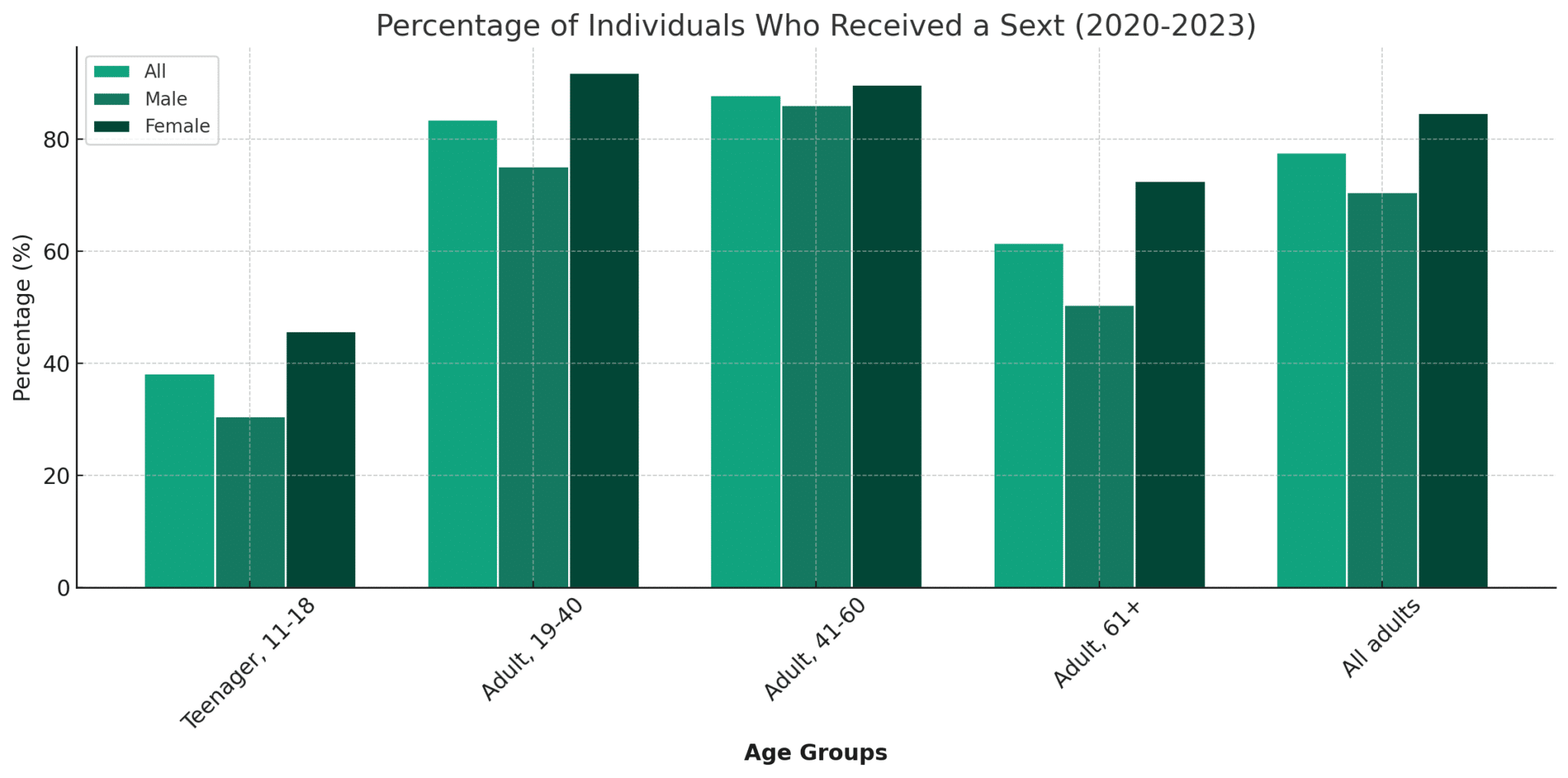
| % Received sext | All | Male | Female |
|---|---|---|---|
| Teenager, 11-18 | 38.2% | 30.6% | 45.8% |
| Adult, 19-40 | 83.5% | 75.2% | 91.9% |
| Adult, 41-60 | 87.9% | 86.1% | 89.7% |
| Adult, 61+ | 61.5% | 50.5% | 72.6% |
| All adults | 77.6% | 70.6% | 84.7% |
Sharing content of private sexting messages without consent
- Males share sexts more than females across all age groups. This is a reversal from the previous trends where females generally sent and received more sexts than males. The disparity is most pronounced in the “Adult, 19-40” age group, where 25.7% of males shared a sext compared to only 2.9% of females.
- The highest percentage of individuals sharing sexts is in the “Adult, 41-60” age group, with 18.2% for all, 28.8% for males, and 7.6% for females. The gender difference here is substantial.
- The “Teenager, 11-18” age group also displays a significant gender gap, with 18.2% of males sharing a sext compared to 7.8% of females.
- In the “All adults” category, the trend continues with males (20.5%) sharing more sexts than females (4.7%).
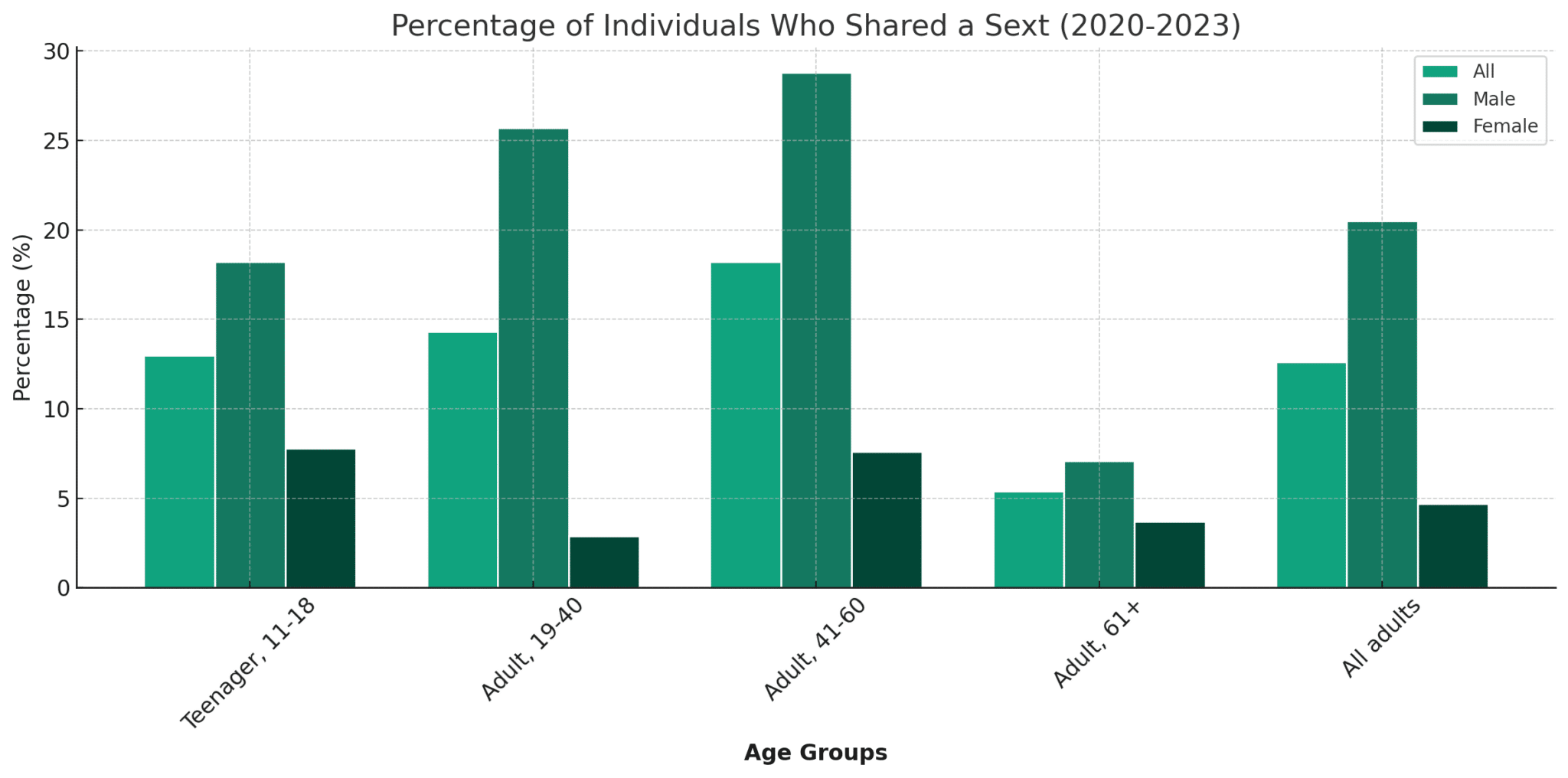
| % Shared sext | All | Male | Female |
|---|---|---|---|
| Teenager, 11-18 | 13.0% | 18.2% | 7.8% |
| Adult, 19-40 | 14.3% | 25.7% | 2.9% |
| Adult, 41-60 | 18.2% | 28.8% | 7.6% |
| Adult, 61+ | 5.4% | 7.1% | 3.7% |
| All adults | 12.6% | 20.5% | 4.7% |
Reasons for sexting
As a part of investigating sexting behaviors respondents were asked to list the reasons they believed they engaged in sexting. Some the the findings from looking into this part of the data is listed below:
- 66% of teenage girls report that they engage in sexting to be flirtatious and fun
- 66% of teenage boys report that they engage in sexting to be flirtatious and fun
- 51% of teenage girls report that pressure from a man was the reason for them engaging in sexting.
- 61% of all respondents report that they have engaged in sexting at least once because they felt pressured to do so.
- 12% have sent nude pictures because they felt pressured into it.
Forwarding/Sharing sexting without consent
While the trend of sharing sexting messages, pictures and videos with others without consent is on the decline in recent years (visible from the graphs of sexting behaviors over time) there are some alarming numbers associated with this:
- 17-18% of people who have engaged in sexting have later (without consent) shared the contents of those interactions with others. This means that almost 1 in 5 recipients of sext later shares it.
- 55% of those that share the contents of a sexting message, share it with multiple people.
Other studies
There are quite a few different surveys and studies available on sexting. All show slightly diverging results.
To provide an overview, here is a table with the summative statistics of those studies.
| Summary statistics for Teenage sexting | % |
|---|---|
| Received sext | 27.4% |
| Send sext | 14.8% |
| Shared sext | 12.0% |
| Had sext shared | 8.4% |
And, below the total overview of the studies on sexting among teenagers.
| Source | Participants, N | Mean age | % male | Type of sexting | Sexting contents | Geographic area |
|---|---|---|---|---|---|---|
| Baumgartner et al (2014) | 14,946 | 13.49 | 49.7 | S | P,V,M | Europe multinational |
| Campbell and Park (2014) | 552 | 14.88 | 52.4 | S,R | P,V | United States |
| Cox Communications (2009) | 655 | 15.5 | 50 | S,R,SH-V | P | United States |
| Dake et al (2012) | 1,289 | 14.58 | 51.7 | S | P,V,M | United States |
| Dowdell et al (2011) | 2,077 | 16.03 | 44.6 | R | P | United States |
| Fleschler Peskin et al (2013) | 1034 | 16.34 | 37.4 | S,R,SH-P | P,V,M | United States |
| Harris et al (2013) | 123 | 16.6 | 44.7 | S,R,SH-P | P,V,M | United States |
| Houck et al (2014) | 410 | 12.34 | 53.4 | S | P,M | United States |
| Kerstens and Stol (2014) | 4,453 | 13.9 | 51.2 | S,R | P,V | the Netherlands |
| Kopecký (2015) | 1,237 | 14 | 44.9 | S | P,V | Czech Republic |
| Kopecký (2014) | 21,372 | 14 | 44.6 | S,SH-V | P,V,M | Czech Republic |
| Lee et al (2016) | 1,612 | 16 | 35.7 | S | P,V | Republic of Korea |
| Lee et al (2015) | 683 | 15.5 | 47 | S,R | P,V | Australia |
| Lenhart (2009) | 800 | 15.07 | 53.6 | S,R | P,V | United States |
| Lippman and Campbell (2014) | 51 | 14.55 | 51 | S,R | P,V | United States |
| Livingstone and Gorzig (2014) | 15,619 | 13.5 | 50 | R | P,M | Europe multinational |
| Marcum et al (2014) | 1,617 | 15.77 | 49.9 | S | P | United States |
| Mishna et al (2010) | 2,186 | 14.5 | 45.3 | S-V | P,M | Canada |
| Mitchell et al (2012) | 1,560 | 14.2 | 49.7 | R | P,V | United States |
| Murray (2014) | 467 | 15.96 | 48.4 | S,R,SH-P | P,V | United States |
| O’Sullivan (2014) | 269 | 17 | 34 | S,R | P | United States |
| Patrick et al (2015) | 2,114 | 16 | 38.4 | S,R | P,V | Australia |
| Rice et al (2012) | 1,714 | 15.23 | 51.9 | S | P,M | United States |
| Rice et al (2014) | 841 | 11.86 | 51.5 | S,R | P,M | United States |
| Ricketts et al (2015) | 1,617 | 15.77 | 49 | S | P | United States |
| Schloms-Madlener (2013) | 189 | 14 | 50.6 | S | P | South Africa |
| Ševčíková (2016) | 17,016 | 16 | 49 | S | P,V,M | Europe multinational |
| NCPTUP (2008) | 163 | 14.5 | 49 | S | P,V | United States |
| Strassberg et al (2013) | 606 | 15.9 | 54.3 | S,R | P | United States |
| Temple et al (2012) | 948 | 15.8 | 44.1 | S | P | United States |
| Van Ouytsel et al (2014) | 1,028 | 16.68 | 42 | S | P | Belgium |
| Van Ouytsel et al (2014) | 329 | 16.71 | 39.8 | S,R | P,V | Belgium |
| Vanden Abeele et al (2014) | 1,943 | 15.28 | 50.6 | S | P,V | Belgium |
| Velarde (2014) | 635 | Not available | 53.4 | S,R,SH-P | P | United States |
| Walrave et al (2014) | 498 | 16.5 | 46 | S | P,M | Belgium |
| Walrave et al (2015) | 217 | 16.72 | 38.2 | S | P,V,M | Belgium |
| Wolfe et al (2016) | 625 | 14.79 | 51.5 | R | P,V | United States |
| Wood et al (2015) | 3,170 | 15.27 | 50 | S,R,SH-V | P,M | Europe multinational |
| Ybarra and Mitchell (2014) | 3,715 | 15.5 | 43.3 | S | P | United States |
| Total | 110,380 | 15.16 | 47.23 | S=34, R=20, SH-V=5, SH-P=4 | P=39, V=21, M=14 | – |
- The National Campaign to Prevent Teen and Unplanned Pregnancy (2009) found that approximately 15% of teens have electronically sent, or posted online, nude or semi-nude images of themselves.
- The Drexel University Study (2012) found that nearly 20% of adults have sexted and that younger adults are more likely to engage in sexting behavior.
- The Pew Research Center Study (2012) found that 4% of cell phone owners have sent sexually explicit images of themselves to someone else and that 15% of cell phone owners have received sexually explicit images.
- The University of Utah Study (2017) found that sexting is a common behavior among young adults and that sexting is associated with higher levels of sexual behavior and risky sexual behavior.
- Other studies have found that sexting can lead to regret and can have legal, social, and psychological consequences.
- Some studies have also found that sexting can be used as a form of cyberbullying, especially when the images are shared without consent.
Some studies have even looked more into the effects and consequences of sexting amongst both adults and teens:
- The University of Texas Health Science Center at Houston (2015) found that sexting is associated with a higher likelihood of sexual behaviors among adolescents.
- The University of New Hampshire (2015) found that sexting is prevalent among college students and is associated with higher rates of sexual behavior.
- The Crimes Against Children Research Center (2010) found that a significant number of youth have been involved in both sending and receiving sexually explicit images.
- The University of Michigan (2015) found that sexting is a common behavior among young adults and that it is associated with higher levels of sexual satisfaction.
- The Yale University School of Medicine (2015) found that sexting is a common behavior among young adults and is associated with risky sexual behavior.
These studies show that sexting is a prevalent behavior among young adults and is associated with a range of sexual behaviors and outcomes. It is important for individuals to understand the potential consequences of sexting and to make informed decisions about their involvement in this behavior.
References
- Barrense-Dias, Y., Berchtold, A., Surís, J. C., & Akre, C. (2017). Sexting and the definition issue. Journal of adolescent health, 61(5), 544-554.
- Klettke, B., Hallford, D. J., & Mellor, D. J. (2014). Sexting prevalence and correlates: A systematic literature review. Clinical psychology review, 34(1), 44-53.
- Gordon-Messer, D., Bauermeister, J. A., Grodzinski, A., & Zimmerman, M. (2013). Sexting among young adults. Journal of adolescent health, 52(3), 301-306.
- Lenhart, A. (2009). Teens and sexting (Vol. 5). Washington, DC: Pew Internet & American Life Project.
- Strasburger, V. C., Zimmerman, H., Temple, J. R., & Madigan, S. (2019). Teenagers, sexting, and the law. Pediatrics, 143(5).
- Strassberg, D. S., McKinnon, R. K., Sustaíta, M. A., & Rullo, J. (2013). Sexting by high school students: An exploratory and descriptive study. Archives of sexual behavior, 42, 15-21.
- Wolak, J., & Finkelhor, D. (2011). Sexting: A typology.
- Mitchell, K. J., Finkelhor, D., Jones, L. M., & Wolak, J. (2012). Prevalence and characteristics of youth sexting: A national study. Pediatrics, 129(1), 13-20.
- Dake, J. A., Price, J. H., Maziarz, L., & Ward, B. (2012). Prevalence and correlates of sexting behavior in adolescents. American Journal of Sexuality Education, 7(1), 1-15.
- Symons, K., Ponnet, K., Walrave, M., & Heirman, W. (2018). Sexting scripts in adolescent relationships: Is sexting becoming the norm?. New Media & Society, 20(10), 3836-3857.
- Temple, J. R., Paul, J. A., Van Den Berg, P., Le, V. D., McElhany, A., & Temple, B. W. (2012). Teen sexting and its association with sexual behaviors. Archives of pediatrics & adolescent medicine, 166(9), 828-833.
- Ahern, N. R., & Mechling, B. (2013). Sexting: Serious problems for youth. Journal of psychosocial nursing and mental health services, 51(7), 22-30.
- Delevi, R., & Weisskirch, R. S. (2013). Personality factors as predictors of sexting. Computers in Human Behavior, 29(6), 2589-2594.
- Weisskirch, R. S., & Delevi, R. (2011). “Sexting” and adult romantic attachment. Computers in human behavior, 27(5), 1697-1701.
- Van Ouytsel, J., Van Gool, E., Walrave, M., Ponnet, K., & Peeters, E. (2017). Sexting: Adolescents’ perceptions of the applications used for, motives for, and consequences of sexting. Journal of Youth Studies, 20(4), 446-470.
- Drouin, M., Coupe, M., & Temple, J. R. (2017). Is sexting good for your relationship? It depends…. Computers in Human Behavior, 75, 749-756.
- Lounsbury, K., Mitchell, K. J., & Finkelhor, D. (2011). The True Prevalence of “Sexting”.
- Van Ouytsel, J., Walrave, M., Ponnet, K., & Temple, J. R. (2019). Sexting. The international encyclopedia of media literacy, 1-6.
- Ringrose, J., Gill, R., Livingstone, S., & Harvey, L. (2012). A qualitative study of children, young people and’sexting’: a report prepared for the NSPCC.
- Agustina, J. R., & Gómez-Durán, E. L. (2012). Sexting: Research criteria of a globalized social phenomenon. Archives of sexual behavior, 41, 1325-1328.
- Döring, N. (2014). Consensual sexting among adolescents: Risk prevention through abstinence education or safer sexting. Cyberpsychology: Journal of Psychosocial Research on Cyberspace, 8(1), 9.
- Strassberg, D. S., Cann, D., & Velarde, V. (2017). Sexting by high school students. Archives of Sexual Behavior, 46, 1667-1672.
- Englander, E. (2019). What do we know about sexting, and when did we know it?. Journal of Adolescent Health, 65(5), 577-578.
- Samimi, P., & Alderson, K. G. (2014). Sexting among undergraduate students. Computers in Human Behavior, 31, 230-241.
- Reyns, B. W., Burek, M. W., Henson, B., & Fisher, B. S. (2013). The unintended consequences of digital technology: Exploring the relationship between sexting and cybervictimization. Journal of Crime and Justice, 36(1), 1-17.
